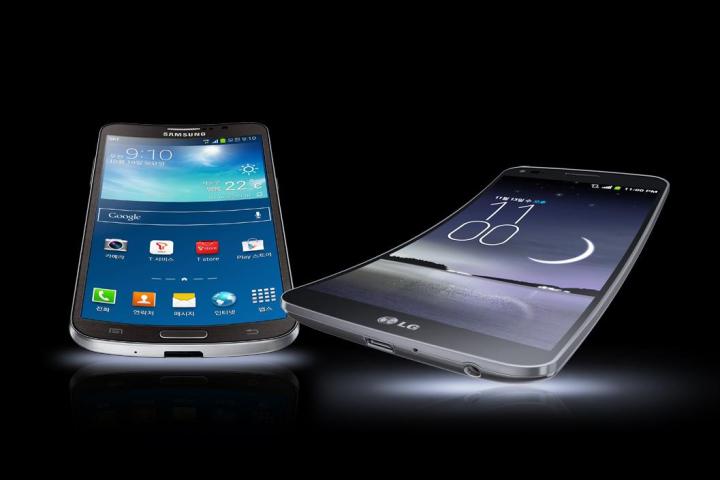
“Real women,” I read once on a movie poster somewhere, “have curves.” And while I can’t say I actually got around to seeing the film, the point stands. In fact, I’d go so far as to suggest that the sentiment can be applied to most of us, fairer sex or no — increasingly so, in these days of desk jobs and bacon-wrapped cheeseburgers. So, why then have our phones grown increasingly flat as society has become, well, more rounded?
If you map the body image of the telephone over the past few decades, you’ll see a gradual transformation of an object built with the shape of the human head in mind, to what’s essentially a flat slab of plastic and glass. That’s the primary motivation behind the LG G Flex and Samsung Galaxy Round, two recently released handset that harness new technologies to offer a slightly different bent to the standard smartphone slab.
If humans are creating the technology, shouldn’t technology be created with humans in mind?
LG and Samsung both seem, at best, cautiously optimistic. After all, the companies have both unveiled new flagship devices in the past month, which, contrary to rumors, take a pre-Magellan approach to phone construction. At the moment, both companies seem to be, at best, dipping their toes in the curved waters at the moment, in hopes that bowed screens will become the next mobile phenomenon, on-par with the phablet explosion of the past few years.
That said, the fact that two off the biggest mobile players embraced curved mobile displays at nearly the exact same time does seem lend some credence to the technology — or at the very least, it calls for a closer examination of the claims put forth in their respective press material. Let’s start with the big claim: We’ve got curves, so why shouldn’t our phones?
This point is part of a larger backlash that we’re seeing pop up all over the electronics industry, and it’s a valid concern. If humans are creating the technology, shouldn’t technology be created with humans in mind? This is why you hear phrases like “natural user interface” to describe the sort of motion control enabled by devices like the Xbox Kinect and leap motion. It’s an attempt to rethink technology in a way that works with our natural movements. And it’s easy to see why it’s been such an appealing concept.

Who wouldn’t want a phone that feels a little better on your face, or sits a bit more comfortably in your back pocket? It’s something we think about every time we hear more promises about flexible displays. It’s exciting to imagine a time when, instead of carrying around massive 7-inch phones for maximum screen real estate, we’ll be able to just pull the things from our back pockets and unfurl them like a roadmap.
But such fantasies only drive home what these new devices aren’t. As much time and effort as no doubt went into building, say, the G Flex (keep in mind that the screen isn’t the only thing you’ve got to curve here), the “Flex” part is hugely overstated, as anyone who’s ever played with the device can tell you. The flexing here is limited to the ability to push the center of the phone down ever so slightly when the phone is resting on its face. Ultimately, the Flex is yet another six-inch phone, bringing with it all of the downsides of lugging around a massive handset. And while you may feel a slight difference with the device pressed up against your face, is anyone using the “phone” part of their smartphone enough for a small curve to make that huge of a difference?
Not really. This ultimately seems to be a case where, like the touchscreen keyboard before it, man has adapted to machine, and we’re doing just fine, thank you very much.
The other principle advantage manufacturers claim for the technology is the same reason they’re now trying to curve all of our TV sets: viewing angles. If you’ve seen one of those new curved sets from (shocker) Samsung or LG, you’ve probably struggled to take in those purported advantages. Now shrink that technology down to six inches, and it becomes harder to detect by orders of magnitude. It also makes one wonder exactly who is gathering the whole family around the old Galaxy Round to watch the latest from Pixar. The argument can be made, perhaps for curving larger displays, but in this form factor, the advantages are minimal at best.

So long as manufacturers continued to relegate curved displays to handsets without much else going for them, the technology will likely never take off. Added to an already great flagship phone, however, the small improvements the curve brings will only serve to make the phones better. I’m all for smartphone manufacturers working to distinguish themselves from the pack of handsets running the same operating system on the same components, but until a company is willing to go all in with the curve, it will continue to be innovation for innovation’s sake.
Editors' Recommendations
- A surprise phone just beat the Galaxy S24 Ultra in a big way
- Samsung may have a big surprise in store with its next folding phone
- I used Samsung’s next big smartphone update. Here’s why I love it
- Have an Android phone? You can get unlimited 5G service for free
- Steve Jobs was wrong. Having a stylus for your phone is great


